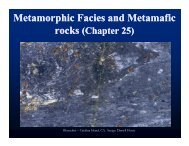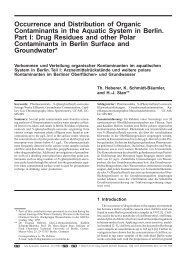Elimination of viruses, bacteria and protozoan oocysts - ResearchGate
Elimination of viruses, bacteria and protozoan oocysts - ResearchGate
Elimination of viruses, bacteria and protozoan oocysts - ResearchGate
Create successful ePaper yourself
Turn your PDF publications into a flip-book with our unique Google optimized e-Paper software.
<strong>Elimination</strong> <strong>of</strong> <strong>viruses</strong>, <strong>bacteria</strong> <strong>and</strong> <strong>protozoan</strong> <strong>oocysts</strong> by<br />
slow s<strong>and</strong> filtration<br />
W.A.M. Hijnen*, J.F. Schijven**, P. Bonné***, A. Visser**** <strong>and</strong> G.J. Medema*<br />
* Kiwa Water Research Ltd., PO Box 1072, 3430 BB Nieuwegein, the Netherl<strong>and</strong>s<br />
(E-mail: wim.hijnen@ kiwa.nl)<br />
** National Institute <strong>of</strong> Public Health <strong>and</strong> the Environment, PO Box 1, 3720 BA Bilthoven, the Netherl<strong>and</strong>s<br />
*** Amsterdam Water Supply, PO Box 8169, 1005 AD, Amsterdam, the Netherl<strong>and</strong>s<br />
**** Dune Water Company South Holl<strong>and</strong>, PO Box 34, 2270 AA Voorburg, the Netherl<strong>and</strong>s<br />
Abstract The decimal elimination capacity (DEC) <strong>of</strong> slow s<strong>and</strong> filters (SSF) for <strong>viruses</strong>, <strong>bacteria</strong> <strong>and</strong><br />
<strong>oocysts</strong> <strong>of</strong> Cryptosporidium has been assessed from full-scale data <strong>and</strong> pilot plant <strong>and</strong> laboratory<br />
experiments. DEC for <strong>viruses</strong> calculated from experimental data with MS2-bacteriophages in the pilot plant<br />
filters was 1.5–2 log 10 . E. coli <strong>and</strong> thermotolerant coliforms (Coli44) were removed at full-scale <strong>and</strong> in the<br />
pilot plant with 2–3 log 10 . At full-scale, Campylobacter <strong>bacteria</strong> removal was 1 log 10 more than removal <strong>of</strong><br />
Coli44, which indicated that Coli44 was a conservative surrogate for these pathogenic <strong>bacteria</strong>. Laboratory<br />
experiments with s<strong>and</strong> columns showed 2–3 <strong>and</strong> >5–6 log 10 removal <strong>of</strong> spiked spores <strong>of</strong> sulphite-reducing<br />
clostridia (SSRC; C. perfringens) <strong>and</strong> <strong>oocysts</strong> <strong>of</strong> Cryptosporidium respectively. Consequently, SSRC was<br />
not a good surrogate to quantify oocyst removal by SSF. Removal <strong>of</strong> indigenous SSRC by full-scale filters<br />
was less efficient than observed in the laboratory columns, probably due to continuous loading <strong>of</strong> these filter<br />
beds with spores, accumulation <strong>and</strong> retarded transport. It remains to be investigated if this also applies to<br />
oocyst removal by SSF. The results additionally showed that the schmutzdecke <strong>and</strong> accumulation <strong>of</strong><br />
(in)organic charged compounds in the s<strong>and</strong> increased the elimination <strong>of</strong> microorganisms. Removal <strong>of</strong> the<br />
schmutzdecke reduced DEC for <strong>bacteria</strong> by ±2 log 10 , but did not affect removal <strong>of</strong> phages. This clearly<br />
indicated that, besides biological activity, both straining <strong>and</strong> adsorption were important removal mechanisms<br />
in the filter bed for microorganisms larger than <strong>viruses</strong>.<br />
Keywords <strong>Elimination</strong> <strong>of</strong> microorganisms; slow s<strong>and</strong> filtration; surrogates<br />
Introduction<br />
Recently the Dutch Drinking Water Decree has been revised (VROM, 2001). Drinkingwater<br />
companies should demonstrate sufficient elimination <strong>of</strong> pathogenic <strong>viruses</strong>, <strong>bacteria</strong><br />
<strong>and</strong> (oo)cysts <strong>of</strong> Cryptosporidium <strong>and</strong> Giardia by treatment to comply with an annual<br />
infection risk lower than 10 –4 per person. This requires quantitative knowledge about the<br />
elimination capacity <strong>of</strong> processes. An initial quantitative microbial risk assessment at the<br />
plants <strong>of</strong> Amsterdam Water Supply (AWS) <strong>and</strong> the Dune Water Company South-Holl<strong>and</strong><br />
(DWS) revealed a lack <strong>of</strong> knowledge about the efficacy <strong>of</strong> their slow s<strong>and</strong> filters for<br />
the removal <strong>of</strong> microorganisms. In collaboration with the National Institute <strong>of</strong> Public<br />
Health <strong>and</strong> the Environment (RIVM) <strong>and</strong> Kiwa Water Research, AWS <strong>and</strong> DWS started a<br />
project to determine the decimal elimination capacity DEC <strong>of</strong> slow s<strong>and</strong> filtration for <strong>viruses</strong>,<br />
<strong>bacteria</strong> <strong>and</strong> <strong>protozoan</strong> <strong>oocysts</strong>. Additional goals were to investigate the effect <strong>of</strong> the<br />
schmutzdecke <strong>and</strong> the s<strong>and</strong>, <strong>and</strong> to verify the validity <strong>of</strong> surrogates used to assess pathogen<br />
elimination capacities.<br />
The project was started by evaluation <strong>of</strong> the literature for removal <strong>of</strong> pathogenic<br />
microorganisms. Simultaneously, full-scale data <strong>of</strong> the elimination <strong>of</strong> indigenous microorganisms,<br />
such as thermotolerant coliforms (Coli44), spores <strong>of</strong> sulphite-reducing clostridia<br />
(SSRC) <strong>and</strong> Campylobacter, were collected <strong>and</strong> reviewed. Both activities did not answer<br />
all the questions. Moreover, the low <strong>and</strong> variable removal <strong>of</strong> SSRC by full-scale filters cast<br />
Water Science <strong>and</strong> Technology Vol 50 No 1 pp 147–154 © IWA Publishing 2004<br />
147
serious doubt on the use <strong>of</strong> these indicators as surrogates for <strong>protozoan</strong> oocyst removal.<br />
Therefore, further experimental research on the pilot <strong>and</strong> laboratory scale has been carried<br />
out, the results <strong>of</strong> which are presented <strong>and</strong> discussed in this paper.<br />
W.A.M. Hijnen et al.<br />
Materials <strong>and</strong> methods<br />
Full-scale data analysis<br />
The elimination <strong>of</strong> thermotolerant coliforms (Coli44) <strong>and</strong> spores <strong>of</strong> sulphite-reducing<br />
clostridia (SSRC) by the SSF at two plants <strong>of</strong> AWS <strong>and</strong> one plant <strong>of</strong> DWS was determined<br />
from data <strong>of</strong> three years <strong>of</strong> routine sampling (n = 32 up to 5,184) <strong>and</strong> <strong>of</strong> a two-week period<br />
in winter <strong>and</strong> summer with daily large-volume sampling (n =≤20). Periodically, the influent<br />
<strong>of</strong> the filters at the location <strong>of</strong> DWS contained Campylobacter <strong>bacteria</strong>, <strong>and</strong> concentrations<br />
before <strong>and</strong> after SSF were measured by large-volume simultaneous sampling. The<br />
decimal elimination capacity DEC, log 10<br />
C in<br />
– log 10<br />
C out<br />
, was calculated from the average<br />
concentration in influent <strong>and</strong> effluent. The average concentration was the total number <strong>of</strong><br />
colony-forming units divided by the total sampled volume (number <strong>of</strong> samples × sample<br />
volume) in the selected period.<br />
Pilot-plant experiments<br />
Under full-scale situations, elimination <strong>of</strong> <strong>viruses</strong> could not be determined; therefore, elimination<br />
<strong>of</strong> bacteriophage MS2 by two slow s<strong>and</strong> filters <strong>of</strong> the AWS pilot plant Leiduin was<br />
determined. MS2 is an icosahedral phage with a diameter <strong>of</strong> 27 nm, <strong>and</strong> is a conservative<br />
surrogate for <strong>viruses</strong> (Schijven et al., 2003). E. coli WR1 was co-injected as a reference to<br />
the elimination <strong>of</strong> indigenous Coli44. The influent <strong>of</strong> SSF1 was surface-water pre-treated<br />
by coagulation floc removal, rapid s<strong>and</strong> filtration 1, dune infiltration followed by an open<br />
collection reservoir, rapid s<strong>and</strong> filtration 2, ozonation, s<strong>of</strong>tening <strong>and</strong> granular activated carbon<br />
filtration. SSF2 was supplied with the filtrate <strong>of</strong> rapid s<strong>and</strong> filter 2. DOC, turbidity <strong>and</strong><br />
pH <strong>of</strong> the influent <strong>of</strong> SSF1 were: 1.5 mg C/l, 0.1 FTU <strong>and</strong> 8.0 respectively, <strong>and</strong> <strong>of</strong> the influent<br />
<strong>of</strong> SSF2: 2.1 mg C/l, 0.7 FTU <strong>and</strong> 8.0 respectively.<br />
The filters (surface area 2.56 m 2 , bed depth 1.5 m <strong>and</strong> 0.3 mm diameter s<strong>and</strong>) were operated<br />
at a filtration rate <strong>of</strong> 0.3 m/h. The filter bed porosity determined with a tracer (NaCl)<br />
test was 0.27. The schmutzdecke <strong>of</strong> SSF1 was scraped 12 d before the experiment. SSF2<br />
was tested with a schmutzdecke <strong>of</strong> 81 d. Then the filter was scraped <strong>and</strong> tested again after 4<br />
d. The temperature ranged from 9.4 to 11.7°C. Before the start <strong>of</strong> the spiking experiments,<br />
MS2 bacteriophages <strong>and</strong> E. coli WR1 were added <strong>and</strong> well mixed in the water above the filter<br />
bed to avoid dilution effects (this was done before each test with different spiking concentrations).<br />
Spiking <strong>of</strong> a low <strong>and</strong> a high concentration <strong>of</strong> MS2 <strong>and</strong> WR1 to the influent <strong>of</strong><br />
the filters (13 mL <strong>of</strong> suspension/min) lasted for two periods <strong>of</strong> 24 h respectively. The effluent<br />
concentrations <strong>of</strong> both microorganisms had been monitored during a 10 d period.<br />
148<br />
Column experiments<br />
Due to the relatively large scale <strong>and</strong> possible health risk in the pilot plant, removal <strong>of</strong><br />
<strong>oocysts</strong> <strong>of</strong> Cryptosporidium was determined in columns <strong>and</strong> compared with elimination <strong>of</strong><br />
spores <strong>of</strong> Clostridium perfringens D10, a possible surrogate for oocyst removal in treatment<br />
(Hijnen et al., 2000). MS2 <strong>and</strong> WR1 were co-injected as references with the pilot<br />
plant <strong>and</strong> full-scale results. A full-scale filter <strong>of</strong> DWS was sampled at four layers (20–40,<br />
40–60, 60–80 <strong>and</strong> 80–100 cm) <strong>and</strong> the AWS pilot plant filter at five layers (20–40, 50–70,<br />
80–100, 110–130 <strong>and</strong> 130–150 cm) for ripened s<strong>and</strong>. In the DWS <strong>and</strong> AWS columns<br />
(diameter 9 cm), the 40 cm s<strong>and</strong> bed was packed with 10 cm <strong>and</strong> 8 cm s<strong>and</strong> <strong>of</strong> each separate<br />
layer <strong>of</strong> sampled s<strong>and</strong>, respectively. Each separate layer was introduced into the column<br />
with water <strong>and</strong> mechanically packed by ticking against the Perspex column. Underneath
this s<strong>and</strong> bed a layer <strong>of</strong> gravel (1–2 mm) had been placed on a rough iron mesh. The influent<br />
(700 L) <strong>of</strong> SSF1 sampled in a large RVS-tank <strong>and</strong> transported to the experimental location,<br />
an unheated hall, was used. The temperature <strong>of</strong> the water varied between 8°C <strong>and</strong> 13.5°C.<br />
The columns were operated at a filtration rate <strong>of</strong> 0.08 m/h for two to three weeks before the<br />
spiking experiment by a peristaltic pump in the filtrate side <strong>of</strong> the columns. The test filtration<br />
rate was increased to 0.3 m/h 48 h before the spiking. The water was inoculated with<br />
microorganisms in a separate RVS-vessel located directly above the s<strong>and</strong> columns (no dilution<br />
effect). During 2 h this inoculated influent was supplied to the columns, <strong>and</strong> during the<br />
following 30 h the concentrations <strong>of</strong> microorganisms in the filtrate were monitored. To verify<br />
the effect <strong>of</strong> co-injection, two columns with AWS s<strong>and</strong> were tested, one spiked with<br />
MS2 <strong>and</strong> E. coli WR1 (AWS1) <strong>and</strong> the other two (AWS2 <strong>and</strong> DWS) spiked with a cocktail<br />
<strong>of</strong> MS2, WR1, Clostridium perfringens (D10) <strong>and</strong> Cryptosporidium parvum.<br />
W.A.M. Hijnen et al.<br />
Microbiological methods<br />
The methods used for Coli44 <strong>and</strong> SSRC in the full-scale study have been described (Hijnen<br />
et al., 2003). The most probable numbers <strong>of</strong> thermophilic Campylobacter <strong>bacteria</strong> in the<br />
water before <strong>and</strong> after SSF <strong>of</strong> DWS were enumerated in 1 mL directly or in 10 mL to 100 L<br />
by isolation over 0.22 µm membrane filters. The samples were pre-cultured in Prestonbouillon<br />
(Ribeiro <strong>and</strong> Price, 1984), in 3 × 3 portions <strong>of</strong> a decimal dilution, for 48 h at 42 ±<br />
0.5°C under microaerophilic conditions. Each <strong>of</strong> these pre-cultures was incubated on solid<br />
Karmali-medium (Karmali et al., 1986) plates (48 ± 2 h at 42 ± 0.5°C microaerophilic).<br />
Typical colonies were grey <strong>and</strong> glancing <strong>and</strong> the cells microscopically confirmed<br />
(Campylobacter cells are mobile <strong>and</strong> have a typical spiral form).<br />
The methods <strong>of</strong> production <strong>and</strong> storage <strong>of</strong> the stock-solutions <strong>and</strong> the enumeration<br />
methods <strong>of</strong> MS2 bacteriophages <strong>and</strong> E. coli WR1 used in the pilot plant study have been<br />
described (Schijven, 2000). WR1 used for the column tests was pre-cultured in autoclaved<br />
tap water with 1 mg/L glucose-C. The production <strong>of</strong> the stock-solution <strong>and</strong> the enumeration<br />
method <strong>of</strong> spores <strong>of</strong> C. perfringens D10 were according to Hijnen et al. (2002).<br />
Cryptosporidium parvum <strong>oocysts</strong> (Moredun, Scotl<strong>and</strong>; harvested by sedimentation <strong>and</strong><br />
differential centrifugation) were spiked from a 1 mL suspension (10 8 <strong>oocysts</strong>). For oocyst<br />
counting, samples <strong>of</strong> 1–200 mL were analysed directly without concentration by the DFA<br />
technique with the Chemscan (Chemunex). Samples were filtered <strong>and</strong> prepared for scanning<br />
with the Chemscan-kit (Chemunex 200 k0009-01 with IMS) including a mounting<br />
medium (85 µL), 25 mm diameter 2.0 µm membrane filters <strong>and</strong> support Pad. The membrane<br />
filters were labelled with 100 µL monoclonal antibody reagents (Oxoid; diluted 1:1<br />
in deionised water) for 30 min at 37°C. The filters were scanned <strong>and</strong> counted spots were<br />
microscopically confirmed based on colour, form <strong>and</strong> size.<br />
Results <strong>and</strong> discussion<br />
<strong>Elimination</strong> <strong>of</strong> <strong>bacteria</strong> <strong>and</strong> <strong>bacteria</strong>l spores by full-scale filters<br />
The process conditions <strong>of</strong> SSF at the three locations <strong>of</strong> AWS <strong>and</strong> DWS showed no large differences<br />
(Table 1).<br />
From the concentrations <strong>of</strong> Coli44 in influent <strong>and</strong> effluent observed in three separate<br />
periods, DEC-values <strong>of</strong> >1.5 up to 3.2 log 10<br />
were calculated (Table 1). The average DEC<br />
for these indicator <strong>bacteria</strong> was 2.6 ± 0.5 log 10<br />
higher than the average DEC <strong>of</strong> 1.9 ± 0.5<br />
log 10<br />
calculated from a number <strong>of</strong> studies in the literature (Poynter <strong>and</strong> Slade, 1977; Slade,<br />
1978; Cleasby et al., 1984; Bellamy et al., 1985; Ellis, 1985). Removal <strong>of</strong> Campylobacter<br />
<strong>bacteria</strong> by SSF at the DWS location Scheveningen was 3.4 ± 0.6 log 10<br />
, 1-log more than<br />
Coli44 removal by these filters (Table 1). This indicated that E. coli was a conservative surrogate<br />
parameter for Campylobacter removal by SSF.<br />
149
Table 1 Decimal elimination capacity (DEC) <strong>of</strong> full-scale slow s<strong>and</strong> filters<br />
Location Weesperkarspel Leiduin Scheveningen<br />
AWS AWS DWS<br />
W.A.M. Hijnen et al.<br />
Filtration rate (m/h) 0.4 0.25 0.25<br />
Bed length (m) 1.5 1.5 1.0<br />
Surface cleaning frequency (year) 1 2 4–5<br />
Grain size (mm) 0.15–0.6 0.13–0.37 0.3–1.8<br />
DEC (log 10 ) Coli44 2.2 a ; >1.5 b ; >3.7 c 3.2 a ; nd d ; nd 2.9 a ; 2.3 b ; 2.2 c<br />
DEC (log 10 ) Campylobacter nd nd 4.1 a ; 3.0 b ; 3.2 c<br />
DEC (log 10 ) SSRC 1.6 a ; 1.5 b ; 1.0 c (1.8) a,e ; –0.2 b,e ; –0.1 c,e 1.8 a ; 0.0 b ; –0.2 c<br />
a three years routine monitoring in small volumes; b,c daily large volume sampling in 2 weeks in winter ( b )<br />
<strong>and</strong> summer ( c ); d not determined; e 1st DEC high (45/L) <strong>and</strong> 2nd <strong>and</strong> 3rd DEC low (0.16/L) SSRC level in<br />
influent C in<br />
0.001<br />
<strong>Elimination</strong> <strong>of</strong> SSRC by SSF varied significantly. The maximum removal was 1.8 log 10<br />
,<br />
but at locations Leiduin (AWS) <strong>and</strong> Scheveningen (DWS), the data also showed little to no<br />
elimination <strong>and</strong> even a small increase in the SSRC numbers (negative DEC). Multiplication<br />
in anaerobic zones cannot be excluded. However, accumulation <strong>and</strong> retarded transport<br />
seemed the most plausible explanations for this phenomenon. Spores not retained irreversibly<br />
by straining or attachment to the s<strong>and</strong> grains, may persist long enough to pass the<br />
s<strong>and</strong> filter eventually in concentrations that may even be higher than in the influent at the<br />
time <strong>of</strong> monitoring. This phenomenon for these spores has also been described by Schijven<br />
et al. (2003), <strong>and</strong> indicated that DEC depended on the duration <strong>of</strong> the contamination.<br />
Hence, it explained the positive correlation between elimination <strong>and</strong> the influent concentration<br />
observed at Leiduin. DEC <strong>of</strong> 1.8 <strong>and</strong> –0.2 log 10<br />
was observed at an average SSRC<br />
influent concentration <strong>of</strong> 45 <strong>and</strong> 0.16 spores/L respectively. These results raised serious<br />
doubts about the use <strong>of</strong> these spores as a quantitative surrogate for Cryptosporidium oocyst<br />
removal by SSF. On the other h<strong>and</strong>, provided that no irreversible attachment or physical<br />
straining had occurred, the same phenomenon <strong>of</strong> breakthrough in the long run may also be<br />
the case for <strong>protozoan</strong> <strong>oocysts</strong> removal by SSF.<br />
Pilot-plant study<br />
Figure 1 shows the breakthrough curves <strong>of</strong> MS2 <strong>and</strong> WR1. The difference between<br />
the average influent <strong>and</strong> maximum effluent concentration was used to estimate DEC. The<br />
tailing after the spiking period <strong>of</strong> 48 h was caused by slow detachment <strong>of</strong> the attached<br />
Concentration org./ml<br />
1,000,000<br />
100,000<br />
10,000<br />
1,000<br />
100<br />
10<br />
1<br />
0.1<br />
0.01<br />
Filter bed<br />
cleaning<br />
MS2 in<br />
MS2 out<br />
WR1 in<br />
WR1 out<br />
150<br />
0 2 4 6 8 10 12 14 16 18 20 22 24<br />
Operational time (days)<br />
Figure 1 The concentrations <strong>of</strong> bacteriophage MS2 <strong>and</strong> E. coli WR1 in the influent <strong>and</strong> effluent <strong>of</strong> SSF2<br />
during two separate spiking experiments with 24 h <strong>of</strong> low <strong>and</strong> 24 h <strong>of</strong> high concentrations; between these<br />
experiments, on d 11, the filter bed surface was cleaned (schmutzdecke was scraped <strong>of</strong>f)
microorganisms (Schijven, 2000). The filters SSF1 <strong>and</strong> SSF2 reduced the concentration <strong>of</strong><br />
both organisms by 1.7 <strong>and</strong> up to 4.2 log 10<br />
(Table 2).<br />
A concentration increase <strong>of</strong> about 3 log 10<br />
(Figure 1) did not significantly affect DEC.<br />
The schmutzdecke <strong>of</strong> 81 d at SSF2 showed a significant effect on the elimination <strong>of</strong> WR1.<br />
Before cleaning <strong>of</strong> the filter bed, DEC was 3.9–4.2 <strong>and</strong> after cleaning 2–2.8 log 10.<br />
MS2<br />
elimination, however, was hardly influenced by the filter bed cleaning <strong>and</strong> was 2.1 ± 0.6<br />
log 10<br />
. This value was similar to the average removal <strong>of</strong> indigenous entero<strong>viruses</strong> by SSF <strong>of</strong><br />
1.9 log 10<br />
observed by others (Slade, 1978; Ellis, 1985). A 3 log 10<br />
removal <strong>of</strong> polio<strong>viruses</strong><br />
by SSF was found by Windle-Taylor (1969), while Poynter <strong>and</strong> Slade (1977) reported a<br />
DEC <strong>of</strong> 3.5 <strong>and</strong> 2.8 log 10<br />
for MS2 phages <strong>and</strong> polio<strong>viruses</strong>. Without a schmutzdecke, WR1<br />
removal was 2.3 ± 0.4 log 10<br />
. This value was close to MS2 removal by the same filters <strong>and</strong> E.<br />
coli removal observed in full-scale filters <strong>and</strong> in the literature.<br />
W.A.M. Hijnen et al.<br />
Column experiments<br />
Due to the relative large scale <strong>and</strong> possible health risk in the pilot plant, removal <strong>of</strong> <strong>oocysts</strong><br />
<strong>of</strong> Cryptosporidium was determined in columns packed with ripened s<strong>and</strong> sampled 20 cm<br />
from the top <strong>of</strong> the filter bed (without schmutzdecke; worst case). The main objective <strong>of</strong><br />
this part <strong>of</strong> the study was to compare the elimination <strong>of</strong> <strong>bacteria</strong>, <strong>viruses</strong> <strong>and</strong> <strong>protozoan</strong><br />
<strong>oocysts</strong> under the same conditions; thus MS2 bacteriophages, E. coli WR1 <strong>and</strong> spores <strong>of</strong><br />
Clostridium perfringens D10 were co-injected with C. parvum. The influent concentrations<br />
ranged from 1.0 × 10 3 to 1.7 × 10 5 /mL. Oocyst levels <strong>of</strong> 10 3 –10 4 /mL were removed completely<br />
(4.5–>6.5 log 10<br />
have been described (Bellamy et al., 1985;<br />
Schuler et al., 1991; Timms et al., 1995). Fogel et al. (1993) determined concentrations <strong>of</strong><br />
indigenous Giardia <strong>and</strong> Cryptosporidium (oo)cysts in the influent <strong>and</strong> effluent <strong>of</strong> a fullscale<br />
plant over a period <strong>of</strong> 1.5 years where much lower DEC values (1.2 <strong>and</strong> 0.3 log 10<br />
removals respectively) were calculated. Figure 1 shows that MS2 phages <strong>and</strong> E. coli were<br />
Table 2 Decimal elimination capacity (log 10 (C in /C max,out )) <strong>of</strong> MS2 bacteriophage <strong>and</strong> E. coli (WR1) <strong>of</strong><br />
SSF1 <strong>and</strong> SSF2 <strong>of</strong> the pilot plant <strong>of</strong> AWS at 10°C<br />
Filter Time (d) after MS2 E. coli<br />
schmutzdecke removal Low C in * High C in Low C in High C in<br />
SSF1 12 1.7 1.8 2.1 2.3<br />
SSF2 81 1.8 2.2 3.9 4.2<br />
SSF2 4 1.7 1.9 2.0 2.8<br />
* influent concentrations<br />
Table 3 Decimal <strong>Elimination</strong> Capacity (log 10 (C in /C max out )) <strong>of</strong> the columns compared to DEC assessed for<br />
full-scale filters<br />
E. coli or Coli44 a MS2 C. perfringens or SSRC a C. parvum<br />
Column AWS1; 0.4 m 0.2 0.4 ns ns<br />
Column AWS2; 0.4 m 0.3 0.2 2.3 >5.3<br />
Full-scale AWS; 1.5 m 2.0 b 1.7 –0.2–1.8 c nd<br />
Column DWS; 0.4 m 0.4 0.1 3.2 >6.5<br />
Full-scale DWS; 1.0 m 2.5 d nd –0.2–1.8 c nd<br />
ns – no spiking; nd – not determined; a indigenous Coli44 <strong>and</strong> SSRC; b average DEC for Coli44 from pilot<br />
plant filters in Table 2; c range <strong>of</strong> values for SSRC from Table 1; d average DEC for Coli44 from full-scale<br />
filters in Table 1<br />
151
W.A.M. Hijnen et al.<br />
hardly removed by the AWS2 column (Figure 2), a result also observed in column AWS1<br />
<strong>and</strong> DWS (Table 3). MS2 <strong>and</strong> WR1 results <strong>of</strong> the AWS columns showed that co-injection<br />
with the other organisms did not affect the elimination <strong>of</strong> MS2 <strong>and</strong> WR1. The columns<br />
removed spores <strong>of</strong> C. perfringens 2–3 log 10<br />
more efficiently than MS2 <strong>and</strong> WR1, but less<br />
efficiently than C. parvum. The latter result demonstrated that SSRC was not a suitable<br />
quantitative surrogate for Cryptosporidium oocyst removal by SSF. A similar conclusion<br />
for aerobic spores as a surrogate for oocyst removal by rapid filtration was drawn by<br />
Emelko (2001).<br />
The column with DWS s<strong>and</strong> (grain size 0.3–1.8 mm) showed more elimination <strong>of</strong> the<br />
<strong>bacteria</strong> <strong>and</strong> <strong>bacteria</strong>l spores than the column AWS2 with finer s<strong>and</strong> (0.13–0.37 mm; Table<br />
3). This difference was possibly caused by a higher carbon <strong>and</strong> iron oxyhydroxide content<br />
<strong>of</strong> 0.055% (dry weight) <strong>and</strong> 2.4 mg/g in the DWS s<strong>and</strong> compared to
pH <strong>and</strong> conductivity. Also, changes in hydraulic conditions may contribute to transport <strong>of</strong><br />
<strong>oocysts</strong> through s<strong>and</strong> beds (Emelko, 2001) with the same author emphasising the need for<br />
further research to elucidate the significance <strong>of</strong> seeding experiments with high concentrations<br />
as a tool to assess DEC <strong>of</strong> full-scale filters for Cryptosporidium.<br />
Conclusions<br />
Based on the results <strong>of</strong> this study with E. coli (Coli44) <strong>and</strong> MS2-bacteriophages, DEC <strong>of</strong><br />
slow s<strong>and</strong> filters for <strong>bacteria</strong> <strong>and</strong> <strong>viruses</strong> was quantified at 2–3 <strong>and</strong> 1.5–2 log 10<br />
, respectively.<br />
One log 10<br />
higher was the elimination <strong>of</strong> indigenous Campylobacter <strong>bacteria</strong> by fullscale<br />
filters, which indicated that Coli44 was a conservative surrogate for these pathogenic<br />
<strong>bacteria</strong>. MS2-bacteriophages could be regarded as a conservative surrogate for virus<br />
removal (low attachment <strong>and</strong> survival rate). Moreover, <strong>viruses</strong> were the most critical<br />
microorganisms for the performance <strong>of</strong> slow s<strong>and</strong> filters, because they were retained the<br />
least. The column experiments showed that SSF will have a high efficacy in eliminating<br />
peak concentrations <strong>of</strong> persistent microorganisms, such as spores <strong>of</strong> sulphite-reducing<br />
clostridia (>2–3 log 10<br />
) <strong>and</strong> (oo)cysts <strong>of</strong> Cryptosporidium <strong>and</strong> Giardia (>5 log 10<br />
). This may<br />
be more in full-scale filters with a schmutzdecke. Therefore, SSRC was not a good quantitative<br />
surrogate for <strong>protozoan</strong> oocyst removal by SSF in practice. Further research will be<br />
needed to elucidate if <strong>and</strong> to what extent accumulation <strong>and</strong> retarded transport, the suggested<br />
phenomena for the low <strong>and</strong> variable removal <strong>of</strong> indigenous SSRC by full-scale filters,<br />
will affect elimination <strong>of</strong> <strong>oocysts</strong> <strong>of</strong> Cryptosporidium in practice in the long run.<br />
Additionally, this study showed that filters with a schmutzdecke had 1–2 log greater capacity<br />
to eliminate <strong>bacteria</strong>, whereas elimination <strong>of</strong> <strong>viruses</strong> was not affected by the<br />
schmutzdecke. This positive effect <strong>of</strong> the schmutzdecke on elimination would also count<br />
for <strong>protozoan</strong> <strong>oocysts</strong>, because straining was an important removal mechanism for these<br />
organisms. Furthermore, results also suggested that charged (in)organic components accumulated<br />
in the s<strong>and</strong> might have a significant effect on the removal efficiency <strong>of</strong> organisms<br />
removed by adsorption.<br />
W.A.M. Hijnen et al.<br />
References<br />
Bellamy, W.D., Silverman, G.P., Hendricks, D.W. <strong>and</strong> Logsdon, G.S. (1985). Removing Giardia cysts with<br />
slow s<strong>and</strong> filtration. J. Am. Wat. Wks. Ass., 77(2), 52–60.<br />
Cleasby, J.L., Hilmoe, D.J. <strong>and</strong> Dimitracopoulos, C.J. (1984). Slow s<strong>and</strong> <strong>and</strong> direct in-line filtration <strong>of</strong> a<br />
surface water. J. Am. Wat. Wks. Ass., 76(12), 44–55.<br />
Ellis, K.V. (1985). Slow s<strong>and</strong> filtration. Crit. Rev. Environ. Control, 15(4), 315–354.<br />
Emelko, M.B. (2001). Removal <strong>of</strong> Cryptosporidium parvum by granular media filtration. Thesis, University<br />
<strong>of</strong> Waterloo, Ontario, Canada.<br />
Fogel, D., Isaac-Renton, J., Guasparini, R., Moorehead, W. <strong>and</strong> Ongerth, J. (1993). Removing Giardia <strong>and</strong><br />
Cryptosporidium by slow s<strong>and</strong> filtration. J. Am. Wat. Wks. Ass., 85(11), 77–84.<br />
Hijnen, W.A.M., Medema, G.J. <strong>and</strong> van der Kooij, D. (2004). Quantitative assessment <strong>of</strong> the removal <strong>of</strong><br />
indicator-<strong>bacteria</strong> in full-scale treatment plants. Wat. Sci. Tech.: Wat. Sup., 4(2), 47–54.<br />
Hijnen, W.A.M., Van der Veer, A.J., Van Beveren, J. <strong>and</strong> Medema, G.J. (2002). Spores <strong>of</strong> sulfite-reducing<br />
clostridia (SSRC) as surrogate for verification inactivation capacity <strong>of</strong> full-scale ozonation for<br />
Cryptosporidium. Wat. Sci. Tech.: Wat. Sup., 2(1), 163–170.<br />
Hijnen, W.A.M., Willemsen-Zwaagstra, J., Hiemstra, P., Medema, G.J. <strong>and</strong> van der Kooij, D. (2000).<br />
Removal <strong>of</strong> sulphite-reducing clostridia spores by full-scale water treatment processes as a surrogate for<br />
<strong>protozoan</strong> (oo)cysts removal. Wat. Sci. Tech., 41(7), 165–171.<br />
Karmali, M.A. et al. (1986). Evaluation <strong>of</strong> a blood-free, charcoal-based, selective medium for the isolation<br />
<strong>of</strong> Campylobacter organisms from faeces. J. Clin. Microbiol., 23, 456–459.<br />
Poynter, S.F.B. <strong>and</strong> Slade, J.S. (1977). The removal <strong>of</strong> <strong>viruses</strong> by slow s<strong>and</strong> filtration. Prog. Water Tech.,<br />
9(?), 75–88.<br />
Ribeiro, C.D. <strong>and</strong> Price, T.H. (1984). The use <strong>of</strong> Preston enrichment broth for the isolation <strong>of</strong> thermophilic<br />
Campylobacters from water. J. Hyg. (Camb)., 92, 45–51.<br />
153
W.A.M. Hijnen et al.<br />
Schijven, J.F. (2000). Virus Removal from Groundwater by Soil Passage. Thesis, Technical University<br />
Delft, ISBN 90-646-4046-7.<br />
Schijven, J.F., de Bruin, H.A.M., Hassanizadeh, S.M. <strong>and</strong> de Roda Husman, A.M (2003). Bacteriophages<br />
<strong>and</strong> Clostridium spores as indicator organisms for the removal <strong>of</strong> pathogens by passage through<br />
saturated dune s<strong>and</strong>. Wat. Res., 37, 2186–2194.<br />
Schuler, P.F., Ghosh, M.M. <strong>and</strong> Gopalan, P. (1991). Slow s<strong>and</strong> <strong>and</strong> diatomaceous earth filtration <strong>of</strong> cysts<br />
<strong>and</strong> other particulates. Wat. Res., 25(8), 995–1005.<br />
Slade, J.S. (1978). Entero<strong>viruses</strong> in slow s<strong>and</strong> filtered water. J. Inst. Wat. Eng. Sci., 32, 530–536.<br />
Timms, S., Slade, J.S. <strong>and</strong> Fricker, C.R. (1995). Removal <strong>of</strong> Cryptosporidium by slow s<strong>and</strong> filtration. Wat.<br />
Sci. Tech., 31(5–6), 81–84.<br />
VROM (2001). Waterleidingbesluit (Drinking Water Decree). Ministry <strong>of</strong> Housing, Physical Planning <strong>and</strong><br />
the Environment, The Hague, The Netherl<strong>and</strong>s.<br />
Windle-Taylor, E. (1969). The removal <strong>of</strong> <strong>viruses</strong> by slow s<strong>and</strong> filtration. Rep. Results Bac. Chem. Biol.<br />
Exam. London Waters 1969–1970, 44, 52.<br />
154


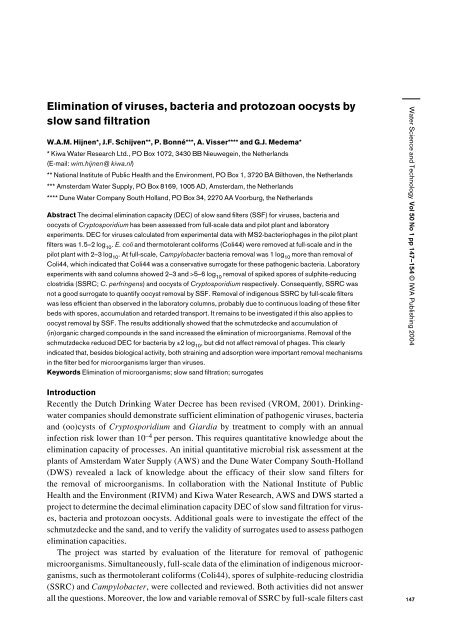


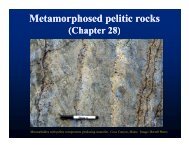

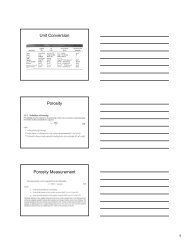


![21-IntroductionMetamorphism [Compatibility Mode].pdf](https://img.yumpu.com/32952021/1/190x146/21-introductionmetamorphism-compatibility-modepdf.jpg?quality=85)
